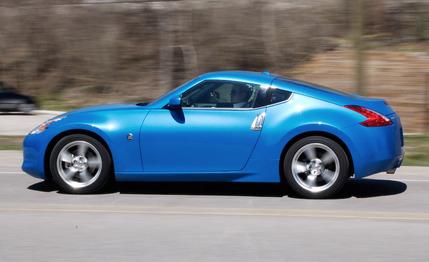
 Short Take Road Test
Short Take Road Test
Chief among the benefits of working at Car and Driver —driving as a job responsibility, Platinum Elite status on Northwest Airlines, lunch at Buffalo Wild Wings on Wednesdays—is the fact that, when it comes time to debate test-car options, there’s no voice in the back of the room asking, “Hey, why don’t we get the automatic?” We are committed to the three-pedal manual. This sometimes feels like being the captain of the Titanic about an hour after meeting the iceberg, however, so we’re always on the lookout for automatics that can satisfy.
Hey, We Found One!
Cars that we already like are often the best place to start that search, which led us to the all-new 2009 Nissan 370Z. Although we would never call an automatic and one of our favorite sports cars a match made in heaven, this one at least seems made somewhere north of purgatory. For starters, the shift paddles are affixed to the steering column, meaning hands always know where to find them. Pull the left for downshifts and the right for upshifts. The shifter can also be used to effect gearchanges.
Moving the shifter to the left from D to manual mode puts the car in a sporting mind-set, with the paddles calling forth sharp, lightning-quick shifts that helped this car set the quickest acceleration times we’ve yet recorded from the new Z: 0 to 60 in 4.6 seconds and the quarter-mile in 13.1 at 108 mph, quicker by 0.2 and 0.3 second and 1 mph than our quickest manual car. With both the automatic and the do-it-yourself transmission, the 370Z is EPA rated at 18 mpg city/26 mpg highway. We saw 18 with the auto, down 1 mpg from the manual 370Z.
A pull on the left paddle nets a rev-matching downshift that will convince any bystander you are using both feet. The one negative we noted was a reluctance to crack off seamless multigear jumps. Call for a two-gear drop, and the engine briefly hangs up on the first before dropping into the second, sapping some of the joy and confidence from quick two-lane passes.
Aside from that hesitation, though, manually selected shifts feel so utterly natural that a passenger might not even notice your hands never leave the wheel as you chase the fast time through a winding backstretch. But they jolt the car so much that you really don’t want to shift for yourself while trundling around town, as there is no way to do so smoothly. Slide the shifter into D, and the car settles into commuting mode with slower and softer gearchanges.
How Many Shifts Would You Need to Reach Warp Speed?
Long ago, in a galaxy east of our Ann Arbor offices, automakers used to make two-speed automatics. But then bicycles started boasting 21 speeds, and car companies developed an inferiority complex. (That might not be the real reason.) Now we’re up to seven- and eight-speed automatics. Eight, we’ll say, are too many ratios unless you need to accelerate to 370 mph. Six are sufficient, and the seven cogs possessed by this Z might be the high end of the acceptable count, if not just past the apogee. Some staffers noted minor gear hunting from the seven-speed on the freeway, but the transmission is smooth enough to go unnoticed most of the time. And the 3.7-liter V-6’s 332 hp and 7500-rpm redline help to stretch the usefulness of each ratio.
The new Z is a great little car: powerful, riotously fun to drive, affordable, and flat-out gorgeous. Opting for the automatic—a $1300 upgrade—doesn’t pollute the experience much, and the slushbox’s character duality means it always behaves the way you want it to. We stand by our commitment to manuals, but if that ship were to sink, we wouldn’t much mind finding ourselves in this lifeboat.